Our colleague Bernhard Maischberger wrote a report about the presentation given by Walter Riess at the last IF Forum in our series “Humans&Knowledge/Science”:
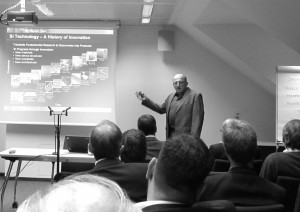
And, indeed, only a small part of all the flood of information and connections we were given can be dealt with in one article.
The first definition was:
What is Nano Technology?
Everything in the range between 1 – 100 nm!
This definition gives us the range we move in.
For your orientation:
A human hair with its cross-section dimension of 60,000 nm is already way beyond. At the top, we are talking of “only“ a few (to be precise, around five) C atoms “in a row“.
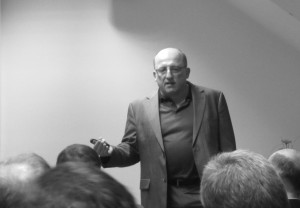
The main issue of Nano Technology is that, due to the smallness of the considered structures, there are very special physical phenomena.
As a similar example in nature, you can see the much-cited lotus effect, where – due to the microscopically very uneven (= large) plant surface nothing will stick to it.
Today, this “technology” is also used for coating roof tiles or other materials. Or consider the “colouring“ of a butterfly wing. Basically, it has no colour. Only the refraction effect makes it shimmer breathtakingly “colourful“.
Back to technology:
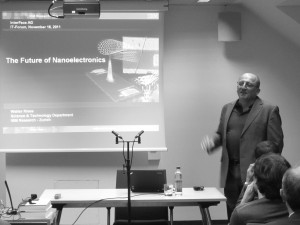
Looking at the increasing hardware miniaturization, you see that the IT industry developed in an unbelievable way over the last 100 years. It dwindled down by 12 digits (from 1 to the 1,000,000,000,000th). No technology or industry ever managed this kind of thing in the same time span.
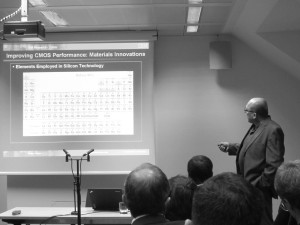
Yet there is a significant disadvantage to the procedure that has now been going on and making structures ever smaller for twenty years. Several years ago, the borderline to “discontinuity“ has been crossed.
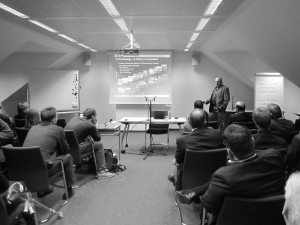
Seeing all this minimizing – which also means additional achievement – you might well get dizzy. Where will it all end?
There is one basic thing that still makes the human brain and all biological systems ever so superior to all technology. That is when we are talking energy efficiency. For example, the brain only needs around 30 – 50 Watt for functioning, whereas all technological systems so far designed that are even remotely capable of the same “computing capacity“ need more than the potency of 10 in energy. Incidentally, it is the most crucial challenge of our future to restrict the enormous amount of energy our current electronics use up, especially in the so-called “idle state“.
On the whole, this was a very densely packed presentation which motivated us to do plenty of thinking. The many highly interesting questions put forward by audience during the subsequent discussion and the always precise and open anwers given by the spokesman will remain unforgotten for a long time.
Bernhard Maischberger
Of course, I was also there. I was allowed to moderate the discussion. Three of the statements by Herrn Dr. habil Walter Riess, in particular, stayed in my memory:
“In each Prius, there are 10 kilograms of ‘rare material!”
when he was asked about the use and re-cycling mechanism of precious raw materials.
“Exponential curves are always dangerous!”
on the discussion about growth.
“By now, the entire thing starts looking a little scary!”
on complexity.
What I liked best about Walter Riess was how he fascinated us with technology while always managing to keep us aware of the responsibility we have towards the environment and society when applying technology.
RMD
(Translated by EG)
P.S.
As soon as I have the video tape with the presentation, I will hand it to the speaker and after getting his consent, I will publish it on my youtube channel RolandDuerre.



